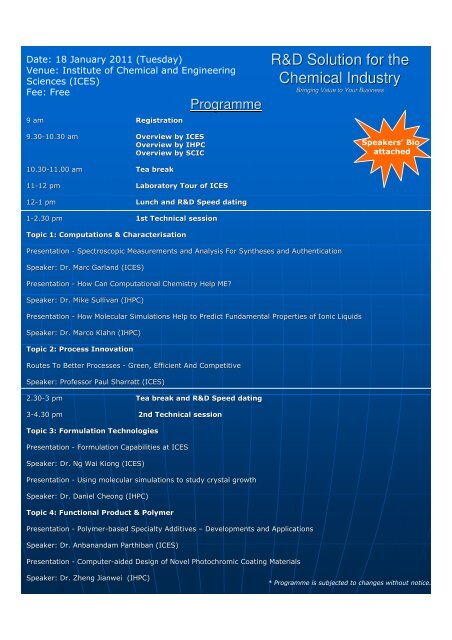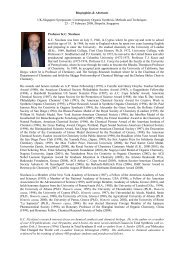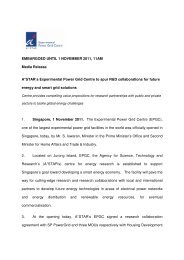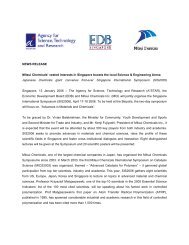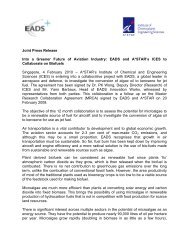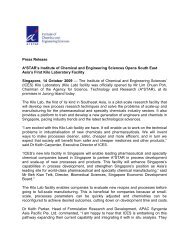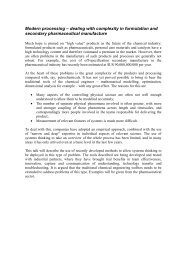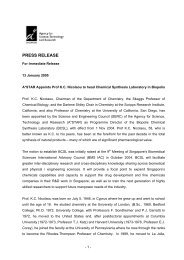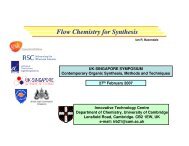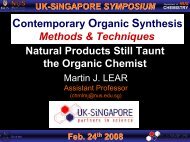here - Institute of Chemical & Engineering Sciences - A*Star
here - Institute of Chemical & Engineering Sciences - A*Star
here - Institute of Chemical & Engineering Sciences - A*Star
You also want an ePaper? Increase the reach of your titles
YUMPU automatically turns print PDFs into web optimized ePapers that Google loves.
Date: 18 January 2011 (Tuesday)<br />
Venue: <strong>Institute</strong> <strong>of</strong> <strong>Chemical</strong> and <strong>Engineering</strong><br />
<strong>Sciences</strong> (ICES)<br />
Fee: Free<br />
9 am Registration<br />
9.30-10.30 am Overview by ICES<br />
Overview by IHPC<br />
Overview by SCIC<br />
Programme<br />
R&D Solution for the<br />
<strong>Chemical</strong> Industry<br />
Bringing Value to Your Business<br />
Speakers’ Bio<br />
attached<br />
10.30-11.00 11.00 am Tea break<br />
11-12 12 pm Laboratory Tour <strong>of</strong> ICES<br />
12-1 1 pm Lunch and R&D Speed dating<br />
1-2.30 pm 1st Technical session<br />
Topic 1: Computations & Characterisation<br />
Presentation - Spectroscopic Measurements and Analysis For Syntheses and Authentication<br />
Speaker: Dr. Marc Garland (ICES)<br />
Presentation - How Can Computational Chemistry Help ME?<br />
Speaker: Dr. Mike Sullivan (IHPC)<br />
Presentation - How Molecular Simulations Help to Predict Fundamental Properties <strong>of</strong> Ionic Liquids<br />
Speaker: Dr. Marco Klahn (IHPC)<br />
Topic 2: Process Innovation<br />
Routes To Better Processes - Green, Efficient And Competitive<br />
Speaker: Pr<strong>of</strong>essor Paul Sharratt (ICES)<br />
2.30-3 3 pm Tea break and R&D Speed dating<br />
3-4.30 pm 2nd Technical session<br />
Topic 3: Formulation Technologies<br />
Presentation - Formulation Capabilities at ICES<br />
Speaker: Dr. Ng Wai Kiong (ICES)<br />
Presentation - Using molecular simulations to study crystal growth<br />
Speaker: Dr. Daniel Cheong (IHPC)<br />
Topic 4: Functional Product & Polymer<br />
Presentation - Polymer-based Specialty Additives – Developments and Applications<br />
Speaker: Dr. Anbanandam Parthiban (ICES)<br />
Presentation - Computer-aided Design <strong>of</strong> Novel Photochromic Coating Materials<br />
Speaker: Dr. Zheng Jianwei (IHPC)<br />
* Programme is subjected to changes without notice.
Technical Talks for 18 January 2011<br />
Speaker <strong>Institute</strong> Title One line Speaker Bio Abstract<br />
Computations and Characterisation<br />
Dr. Marc ICES<br />
Garland<br />
Dr. Michael<br />
Sullivan<br />
IHPC<br />
Spectroscopic<br />
Measurements<br />
and Analysis<br />
For Syntheses<br />
and<br />
Authentication<br />
How Can<br />
Computational<br />
Chemistry<br />
Help ME?<br />
This talk will focus on<br />
unique techniques<br />
developed at ICES for<br />
understanding process<br />
chemistry quickly. This<br />
approach can be<br />
similarly used to<br />
address authenticity<br />
issues <strong>of</strong> commercial<br />
products.<br />
The talk will introduce<br />
a range <strong>of</strong><br />
computational<br />
chemistry tools and<br />
how they can be used<br />
to solve chemical<br />
problems.<br />
Marc Garland studied chemical<br />
engineering and received his Ph.D.<br />
from the Swiss Federal <strong>Institute</strong> <strong>of</strong><br />
Technology in Zurich. T<strong>here</strong>after, he<br />
did a postdoc in the Central Research<br />
labs <strong>of</strong> Ciba Geigy AG in Basel and<br />
then returned to the ETH-Zurich as<br />
Oberassistent (lecturer). He was<br />
Associate Pr<strong>of</strong>essor at the National<br />
University <strong>of</strong> Singapore. He is<br />
currently the team leader for the<br />
Advanced Reaction <strong>Engineering</strong>,<br />
Process Analytics and Chemometrics<br />
group in ICES.<br />
Dr. Sullivan is a computational<br />
chemist who spent the early part <strong>of</strong><br />
his life in Minnesota USA w<strong>here</strong> he<br />
received his B.A. cum laude in<br />
chemistry with All College Honors<br />
from St. John’s University in 1995 and<br />
then his Ph.D. from the University <strong>of</strong><br />
Minnesota for his work in<br />
In situ spectroscopic measurements <strong>of</strong><br />
chemically reactive systems can provide<br />
considerable insight into process chemistry.<br />
At ICES, syntheses are routinely subjected<br />
to simultaneous FTIR and Raman<br />
measurements. Typically, thousands <strong>of</strong><br />
spectra are measured, and then subjected<br />
to band-target entropy minimisation<br />
(BTEM), a s<strong>of</strong>tware developed by ICES<br />
researchers. This provides the pure<br />
component spectra <strong>of</strong> the species present<br />
as well as their concentrations. Often<br />
species at very low concentrations, i.e.<br />
1ppm, can be identified. A similar approach<br />
using spectroscopic microscopy can be<br />
taken to address authentication issues.<br />
Examples <strong>of</strong> both are provided.<br />
Computer simulation techniques can help<br />
research and production in many ways.<br />
Determining the mechanism behind<br />
experimental phenomenon, designing new<br />
materials and products, and<br />
troubleshooting are just a few examples.<br />
We use computers to determine chemical<br />
properties, including structures and
Speaker <strong>Institute</strong> Title One line Speaker Bio Abstract<br />
computational chemistry with Dr.<br />
Christopher Cramer in 2000. He then<br />
moved to the Australian National<br />
University to work as a post-doctoral<br />
fellow with Leo Radom for two and a<br />
half years. From t<strong>here</strong>, he spent a<br />
year at the Singapore-MIT Alliance<br />
and then to the <strong>Institute</strong> <strong>of</strong> High<br />
Performance Computing (IHPC)<br />
w<strong>here</strong> he has been since 2004. He is<br />
currently the Deputy Programme<br />
Manager for the Computational<br />
Materials Science and <strong>Engineering</strong><br />
Programme and also holds an adjunct<br />
position in the Chemistry Department<br />
at the National University <strong>of</strong><br />
Singapore.<br />
Dr. Marco<br />
Klahn<br />
IHPC<br />
How<br />
Molecular<br />
Simulations<br />
Help to Predict<br />
Fundamental<br />
Properties <strong>of</strong><br />
Ionic Liquids<br />
This talk will share<br />
how to use our<br />
computational toolbox<br />
for multi-scale<br />
simulations. For this<br />
work, we apply it to<br />
ionic liquids.<br />
Dr. Klahn obtained in 1999 a Master’s<br />
degree at the University <strong>of</strong><br />
Dortmund, Germany, in Physics, and<br />
in 2003 a Ph.D. at the University <strong>of</strong><br />
Bochum, Germany, in the field <strong>of</strong><br />
theoretical Biophysics. For his<br />
doctoral thesis he developed a<br />
method to simulate IR spectra <strong>of</strong><br />
charged protein substrates.<br />
Subsequently, Dr. Klahn joined Pr<strong>of</strong>.<br />
Arieh Warshel’s lab at the University<br />
<strong>of</strong> Southern California, Los Angeles,<br />
as a Research Fellow, working in the<br />
field <strong>of</strong> computational chemistry and<br />
enzymology. His research activities<br />
energies. With an increase in computer<br />
technology and more robust algorithms,<br />
computational chemistry is a more viable<br />
option for molecular study. In this talk, I will<br />
review some <strong>of</strong> the techniques used in<br />
computational chemistry and highlight how<br />
these techniques can be used to solve your<br />
problems.<br />
Ionic liquids (IL) are molten salts with<br />
extraordinarily low melting points below<br />
100 °C or even below room temperature.<br />
ILs are characterised by unique properties<br />
such as negligible volatility, high thermal<br />
and chemical stability, a large ion<br />
conductivity and favorable solvation<br />
properties for instance. It has been<br />
demonstrated in numerous experiments<br />
that even small variations <strong>of</strong> the<br />
constituting ions can change most <strong>of</strong> the IL<br />
properties over a wide range <strong>of</strong> values. A<br />
fundamentally important property <strong>of</strong> ILs is<br />
the dependence <strong>of</strong> their behavior on the<br />
particular ions that constitute it and the
Speaker <strong>Institute</strong> Title One line Speaker Bio Abstract<br />
involved, among others, phosphate<br />
hydrolysis in solution and proteins as<br />
well as advancing free energy<br />
calculation methods. Dr. Klahn is<br />
affiliated since 2007 to the <strong>Institute</strong><br />
<strong>of</strong> High Performance Computing,<br />
A*STAR, Singapore. His research field<br />
is molecular simulations <strong>of</strong> s<strong>of</strong>t<br />
matter, in particular biomaterials and<br />
ionic liquids.<br />
water concentration in ILs.<br />
The aim <strong>of</strong> the presented work is to predict<br />
these properties <strong>of</strong> new ILs without<br />
experiments by use <strong>of</strong> molecular simulation<br />
techniques and the construction <strong>of</strong> an<br />
empirical model. This model has been<br />
applied to a sample <strong>of</strong> 83 different ILs for<br />
which the water-miscibilities were<br />
predicted correctly.<br />
Process Innovation<br />
Pr<strong>of</strong>essor ICES<br />
Paul Sharratt<br />
Routes To<br />
Better<br />
Processes -<br />
Green,<br />
Efficient And<br />
Competitive<br />
This talk describes the<br />
strategies, skills and<br />
resources used at ICES<br />
and how they can be<br />
deployed to bring<br />
incremental or step<br />
change improvements<br />
in manufacturing<br />
performance.<br />
Paul Sharratt has been the<br />
Programme Manager for Process<br />
Science and Modelling at the <strong>Institute</strong><br />
<strong>of</strong> <strong>Chemical</strong> and <strong>Engineering</strong> <strong>Sciences</strong><br />
in Singapore since 2008. Following a<br />
first degree in Cambridge, Paul was<br />
awarded a PhD for work in catalytic<br />
reaction engineering (1987) from the<br />
University <strong>of</strong> Manchester. He then<br />
spent 4 years working for Imperial<br />
<strong>Chemical</strong> Industries as a process<br />
engineer, gaining experience in<br />
research, development, design and<br />
operation in manufacture <strong>of</strong><br />
agrochemicals and other low tonnage<br />
(batch) products. He returned to<br />
UMIST (now the University <strong>of</strong><br />
Manchester) in 1991 and was<br />
promoted to a full Chair in 2001. He<br />
was awarded a Royal Academy <strong>of</strong><br />
<strong>Engineering</strong> / EPSRC Chair in<br />
The specialty and fine chemicals sectors<br />
have traditionally delivered high value,<br />
science-based products. This alone used to<br />
be enough to be competitive, but now<br />
competition from low cost manufacturers,<br />
environmental concerns, shortening<br />
product life cycles and greater demands for<br />
quality mean that companies need to<br />
address their manufacturing technologies.<br />
ICES has a number <strong>of</strong> capabilities that<br />
address both process improvement and<br />
innovative manufacturing. These range<br />
from statistically based techniques to pilot<br />
scale process demonstration <strong>of</strong> innovation.<br />
The deployment <strong>of</strong> process analytical<br />
techniques at both development laboratory<br />
and pilot scales can rapidly bring rich<br />
process understanding, enabling better<br />
control and robustness. Our work in<br />
continuous processing <strong>of</strong>fers the prospect<br />
<strong>of</strong> step-change improvements in process
Speaker <strong>Institute</strong> Title One line Speaker Bio Abstract<br />
Innovative Manufacturing for the<br />
period 2001-6 and until 2008 he was<br />
capability - processes that are more<br />
efficient, cleaner and robust.<br />
Pr<strong>of</strong>essor <strong>of</strong> Sustainable Processing in<br />
the School <strong>of</strong> <strong>Chemical</strong> <strong>Engineering</strong><br />
and Analytical Science (SCEAS) in the<br />
University <strong>of</strong> Manchester. He still<br />
holds an honorary chair in<br />
Manchester as well as the<br />
Universidad Major de San Marcos in<br />
Lima, and is a fellow <strong>of</strong> the Institution<br />
<strong>of</strong> <strong>Chemical</strong> Engineers. His current<br />
work is in chemical and<br />
pharmaceutical process development<br />
and design, sustainable development<br />
and reaction engineering. He has<br />
active collaborations with many<br />
pharmaceutical and other companies.<br />
Formulation Technologies<br />
Dr. Ng Wai<br />
Kiong<br />
ICES<br />
Formulation<br />
Capabilities at<br />
ICES<br />
The use <strong>of</strong> advanced<br />
modern analytical<br />
methods to better<br />
understand the<br />
science <strong>of</strong> formulated<br />
products as well as<br />
novel formulation<br />
techniques to improve<br />
their application<br />
properties<br />
Dr. Ng obtained his Ph.D. in fluidised<br />
bed drying from the National<br />
University <strong>of</strong> Singapore under the<br />
supervision <strong>of</strong> A/Pr<strong>of</strong>. Reginald Tan<br />
and his Diplom Ingenieur (Master’s<br />
degree) in <strong>Chemical</strong> <strong>Engineering</strong> from<br />
the Technical University <strong>of</strong> Clausthal,<br />
Germany. He is Team Leader <strong>of</strong><br />
Formulation <strong>Sciences</strong> in ICES and has<br />
research interests in novel<br />
formulations, particle technology,<br />
powder processing, particularly in the<br />
analysis <strong>of</strong> physicochemical and solidstate<br />
properties <strong>of</strong> pharmaceutics<br />
Today, the “art <strong>of</strong> formulation” has<br />
transformed itself into an inter-disciplinary<br />
scientific expertise involving physics,<br />
chemistry, colloid and interfacial science,<br />
particle technology and engineering. The<br />
traditional recipe-based approach alone can<br />
no longer meet the demands <strong>of</strong> the highly<br />
competitive specialty chemical landscape<br />
with an ever increasing need for novel<br />
products and applications. Some examples<br />
<strong>of</strong> case-studies will illustrate how the<br />
advances in modern analytical instruments<br />
have enabled further understanding <strong>of</strong> the<br />
physicochemical, solid-state and rheological
Speaker <strong>Institute</strong> Title One line Speaker Bio Abstract<br />
and specialty chemicals. He was<br />
previously Head <strong>of</strong> Industrial<br />
Programme Development group in<br />
ICES. He has also worked for Sulzer<br />
Chemtech, a Switzerland-based<br />
global leader in mass transfer<br />
technologies and managed the<br />
Applied Process Technology group,<br />
which is responsible for the design<br />
and application <strong>of</strong> processing<br />
technologies in Asia-Pacific such as<br />
distillation, absorption, extraction,<br />
membrane separation, crystallisation<br />
and static mixing.<br />
Dr. Daniel<br />
Cheong<br />
IHPC<br />
Using<br />
molecular<br />
simulations to<br />
study crystal<br />
growth<br />
This talk will show how<br />
computer simulations<br />
can be used to study a<br />
complex phenomenon<br />
such as crystal growth.<br />
In this work, we are<br />
looking at the growth<br />
<strong>of</strong> glycine crystal from<br />
its solution.<br />
Dr. Cheong obtained his Ph.D. in<br />
<strong>Chemical</strong> <strong>Engineering</strong> from Princeton<br />
University in 2006, w<strong>here</strong> he was<br />
using Monte Carlo simulations to<br />
study the phase transitions in model<br />
ionic systems. T<strong>here</strong>after, he joined<br />
IHPC w<strong>here</strong> he is the team leader <strong>of</strong><br />
the Computational Chemistry team in<br />
the Computational Materials Science<br />
programme since 2009. His current<br />
interest is in using molecular<br />
dynamics simulations to study crystal<br />
growth.<br />
properties <strong>of</strong> the formulation, and how<br />
these are translated into improved desired<br />
application properties.<br />
Crystallisation is an important process that<br />
is widely used for separation and<br />
purification in the pharmaceutical and<br />
chemical industries. It is highly desirable to<br />
be able to control the crystallisation process<br />
because crystal habit and polymorphism<br />
can affect various properties <strong>of</strong> the<br />
crystallised material. However, the<br />
crystallisation process is affected by many<br />
factors, including temperature, solute<br />
concentration, pH, solvent, impurities, and<br />
additives. The complex interplay <strong>of</strong> all<br />
these factors during crystallisation make it<br />
extremely difficult to predict and control<br />
the resulting crystal habit. A good<br />
understanding <strong>of</strong> how these factors relate<br />
to each other and affect the crystallisation<br />
process is critical to being able to selectively
Speaker <strong>Institute</strong> Title One line Speaker Bio Abstract<br />
design crystallisation conditions to achieve<br />
the desired product. This talk will show<br />
how molecular dynamics simulations can be<br />
used to study a complex phenomenon such<br />
as crystal growth. In this work, we are<br />
looking at the growth <strong>of</strong> glycine crystal from<br />
its solution.<br />
Functional Product and Polymer<br />
Dr.<br />
Anbanandam<br />
Parthiban<br />
Dr. Zheng<br />
Jianwei<br />
ICES<br />
IHPC<br />
Polymer-based<br />
Specialty<br />
Additives –<br />
Developments<br />
and<br />
Applications<br />
Computeraided<br />
Design<br />
<strong>of</strong> Novel<br />
Our recent efforts on<br />
the synthesis <strong>of</strong><br />
polymers with unique<br />
structures which may<br />
be highly relevant to<br />
specialty chemical<br />
industry will be<br />
discussed. The<br />
presentation will also<br />
include a case study on<br />
high char forming<br />
polymer which was<br />
tested as a fire<br />
retardant additive by a<br />
standard test method<br />
in a commercial<br />
testing lab.<br />
A case study with a<br />
local company on<br />
using simulation<br />
Dr. Parthiban is a Research Scientist<br />
in the <strong>Institute</strong> <strong>of</strong> <strong>Chemical</strong> and<br />
<strong>Engineering</strong> <strong>Sciences</strong> (ICES). His<br />
research interests include design and<br />
synthesis <strong>of</strong> organic polymers,<br />
polymers with pendant functional<br />
groups, specialty polymers, metal<br />
catalysed radical polymerisations,<br />
block and graft copolymers, polymers<br />
from renewable resource monomers,<br />
biodegradable/biocompatible<br />
polymers, etc. He has the experience<br />
<strong>of</strong> developing processes from lab<br />
scale (1 kg) to pilot scales (500 kg).<br />
His current research involves the<br />
development <strong>of</strong> specialty polymers,<br />
polymers with pendant functional<br />
groups, fire retardants, block and<br />
graft copolymers and metal catalysed<br />
radical polymerisation <strong>of</strong> vinyl<br />
monomers.<br />
Dr. Zheng Jianwei is a Research<br />
Scientist in the Computational<br />
Materials Science & <strong>Engineering</strong><br />
A high char forming polymer was recently<br />
developed in ICES. This polymer which is<br />
free <strong>of</strong> halogen, phosphorus and nitrogen<br />
atoms, was evaluated as an<br />
environmentally benign fire retardant by a<br />
standard test method. This presentation will<br />
discuss in detail the mechanism behind the<br />
char formation and the preliminary<br />
evaluation as an intumescent additive.<br />
Some <strong>of</strong> the polymers developed as surface<br />
modifying additives which were found to<br />
make surfaces from strongly hydrophilic to<br />
superhydrophilic when doped in coating<br />
samples will also be discussed. The<br />
presentation will also cover different types<br />
<strong>of</strong> gels such as hydrogels, ion gels and<br />
superabsorbent polymers developed in<br />
ICES.<br />
The term “fading rate” is defined as the<br />
speed that photochromic dyes change from<br />
coloured to colourless. The fading rate is
Speaker <strong>Institute</strong> Title One line Speaker Bio Abstract<br />
Photochromic<br />
Coating<br />
Materials<br />
techniques to develop<br />
a new coating<br />
material.<br />
program in IHPC. He is experienced in<br />
both computer simulation and<br />
materials research. His current<br />
research areas are polymeric<br />
materials, photocatalysts,<br />
functionalisation <strong>of</strong> nanotubes &<br />
graphene, and anode materials for Liion<br />
batteries. He has succeeded in<br />
using computer simulation to solve<br />
industrial problems for several<br />
companies including Delphi<br />
(Singapore), HP (US), Sony<br />
(Singapore), Rolls Royce (UK),<br />
Cooksons (Singapore) and Polycore<br />
(Singapore) etc. He has received<br />
several grants including a Singapore-<br />
China joint research grant, a MOE<br />
tier2 grant, an A*STAR nano-initiative<br />
funding and an A*STAR PSF grant. He<br />
has filed three invention disclosures,<br />
two US patents and one PCT patent.<br />
The PCT patent has been granted.<br />
one <strong>of</strong> the key factors in applications <strong>of</strong><br />
photochromic materials. As the reversible<br />
color change <strong>of</strong> photochromic dyes is<br />
caused by a reversible molecular structure<br />
change, it is essential that the materials<br />
provide sufficient free space for this change<br />
to occur. However, traditional polymeric<br />
lenses and coatings are unable to facilitate<br />
fast fading due to the lack <strong>of</strong> free space.<br />
Guiding by computer simulation, the<br />
researchers from IHPC-A*STAR and<br />
Polycore Optical Pte Ltd developed a<br />
technology to solve the slow fading<br />
problem. The details will be introduced in<br />
this talk.


